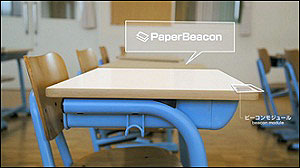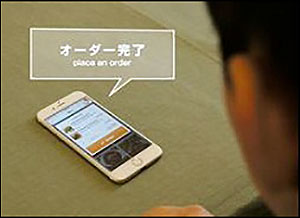Teijin, a Japanese manufacturer of advanced materials, has partnered with TagCast, a maker of Bluetooth beacons, to create a new product called PaperBeacon, which the companies are promoting as an application for digital check-ins, document sharing or electronic payments.
PaperBeacon uses a flat, flexible antenna made by Cellcross, a Japanese company that was spun out from the University of Tokyo in 2002. The antenna technology, which Japanese glass manufacturer AGC Asahi Glass uses to track RFID-tagged documents, is constructed in a manner that strictly controls the radio frequency field it generates in order to support applications wherein only wireless devices laid atop the antenna are read. Rather than incorporating an ultrahigh-frequency (UFH) RFID reader, PaperBeacon contains a TagCast Bluetooth radio. The antenna sheet is 1.5 millimeter (0.06 inch) thick (the Bluetooth module embedded in it is roughly the size of a matchbook, and is located in a corner of the PaperBeacon, which is approximately the size of a placemat). The PaperBeacon has a one-year expected battery life.
The reach of the TagCast beacon signal is designed to extend just above the antenna’s surface. That way, only the Bluetooth-enabled device that is placed directly onto the PaperBeacon collects its identification number, which triggers a PaperBeacon application running on the device to start some designated function.
In a video promotion, the companies offer up two use cases. In one scenario, a roomful of schoolchildren place their electronic tablets atop their desks, each of which has an embedded PaperBeacon. The Bluetooth module in the PaperBeacon transmits its unique identifier, which is collected by the Bluetooth transceiver embedded in the student’s tablet. A PaperBeacon app running on the tablet then uploads this number to a TagCast cloud-based server in order to authenticate the device. Once the tablet is authenticated, two things happen: The student’s attendance is automatically logged into the teacher’s electronic attendance-tracking application, and the day’s learning materials are automatically downloaded onto that child’s tablet. (This was just a demonstration, however. In an actual deployment, the attendance-tracking and electronic textbook application software would be developed by the end user or a reseller.)
In a second scenario, developed by U.S.-based startup PutMenu, a student meets his mother for a meal at a nearby diner. In front of each of them (under a tablecloth) sits a PaperBeacon. The student opens the restaurant’s menu app on his smartphone and selects his and his mother’s orders. He then places his phone on the table, and the Bluetooth transceiver in his handset collects the PaperBeacon ID and uploads that information, along with the order, to the eatery’s point-of-sale system. The POS system notes where the boy and his mother are seated, based on the PaperBeacon ID. Voilà, two burgers arrive.
PutMenu is also developing an application through which diners could pay for their meals using the PaperBeacon and a special payment application, according to TagCast.
The food-ordering app could also be used in non-traditional settings, such as sports stadiums, where fans could order and pay for their food using a PaperBeacon embedded in, say, the back of the seat in front of them. Servers would then bring the food straight to their seat.
The PaperBeacon device, along with a software development kit and application programming interfaces (APIs) provided by TagCast—which can be used to develop specific applications for the PaperBeacon—are available worldwide now. Teijin is manufacturing PaperBeacon, and TagCast will handle sales and maintenance. The companies say they expect to deliver 10,000 PaperBeacon units within the current fiscal year ending in March 2016.



